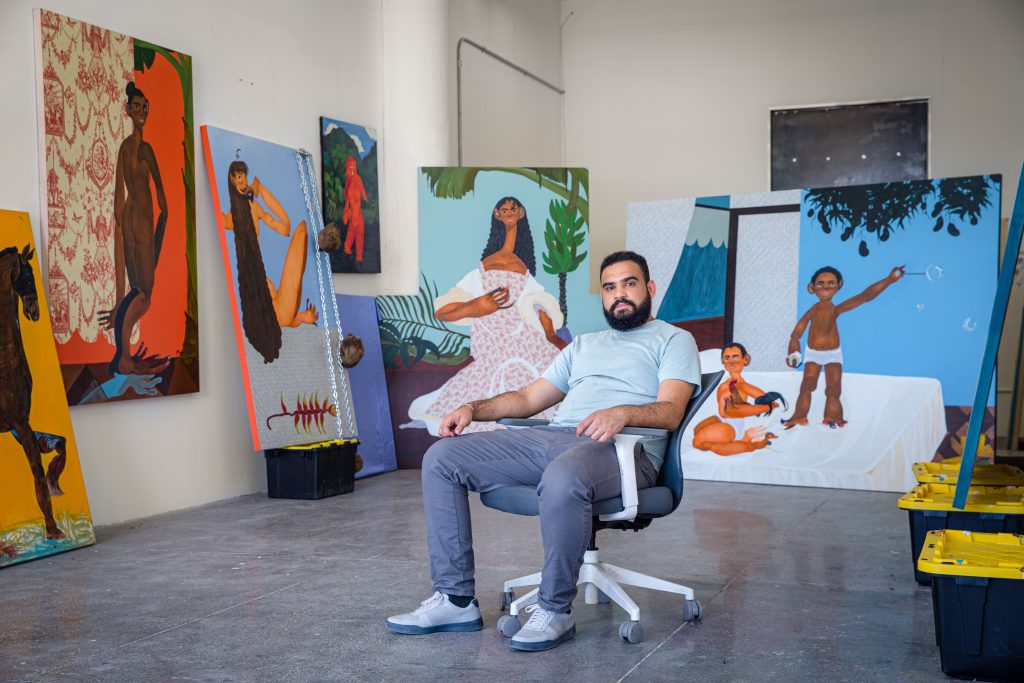If we learned one thing through the trials and tribulations of the early 2020s, it’s that there is no one-size-fits-all approach to identity.
The art world has finally gone beyond “Latin American” art produced by canonized and crossover masters of the past and is attempting to grasp the practice of “Latinx” artists. However, in doing so, many are making the mistake of applying the now-antique frames employed to neatly integrate “Latin American” art into the canon for scholastic coherence or commercial gain. Now, scholars, writers, and patrons have the unprecedented opportunity to engage authentically with art produced by those who hail from the non-Anglophone nations of the Western hemisphere, and those who have joined the U.S. population from these countries.
I do not use the terms “Latino,” “Latinx,” or “Latin American” without quotes. Many members of the population that these words aspire to label do not identify with them. I had the privilege to speak with the contemporary Dominican artist Bony Ramirez about identity and its expression in his art. His name evokes his painted figures of every shape, color, and age. The characters and their environment are inspired by the artist’s memories of the Dominican Republic’s countryside. His process brings the characters into existence intimately with pastel and colored pencil on paper. He attaches finalized portraits to a wood board, the negative space teeming with lush jungle, mountains, or oceans. Like the religious icons of his youth, Ramirez’s images have coded messages in their objects, with a goal to educate the viewer about life in the Caribbean, presenting the humanity of the region that is obscured by tourism.
It would seem that Ramirez’s two-dimensional works and sculptures connect most deeply with the people who lived or remain in the Caribbean and the surrounding countries. However, that would be a false conclusion. His subtly didactic works satisfy not just this cohort’s saudade (a Portuguese word that means the sad state of intense longing for someone, something, or someplace that is absent); they ease a longing that most viewers do not even realize they have.
Ramirez’s narratives bring viewers across the ocean to understand the bittersweet reality of Caribbean life. That’s more poignant now more than ever, as the art world seeks a way to address these makers and their miracles.
Art of the Americas, live through April 21 on Artnet Auctions, offers a selection of works by artists from every corner of the Americas. Browse the sale, and read on to learn how Ramirez’s identity impacts his figurative works.
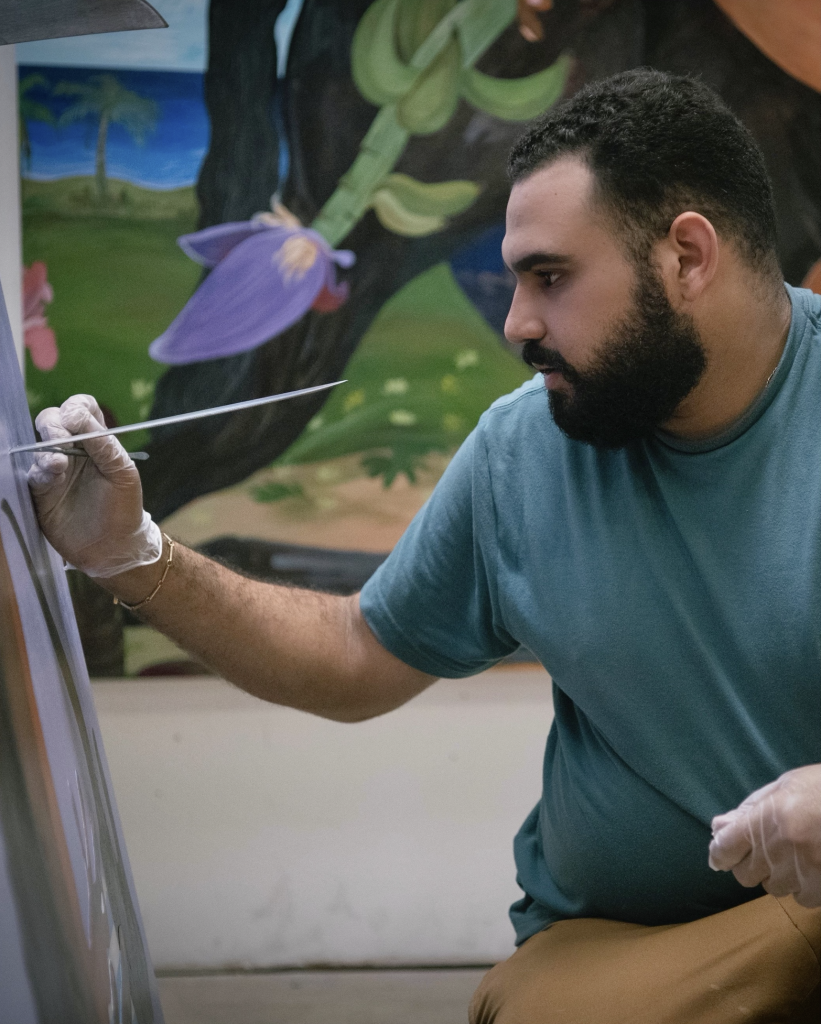
Ramirez in his studio. Courtesy of Frenel Morris.
What is your preferred way to talk about your identity? Do you prefer to be referred to as Dominican, Dominican American, Latinx, Latin@, or Latin American?
I always say I am a Dominican or Caribbean artist. It’s only one or the other. It’s tricky for us, in the Caribbean, because we speak Spanish and we’re part of Latin America. But islands just miles from us are not. The Dominican Republic is only seen through a specific lens in the U.S.
I came to this country in 2009, when I was 13. So, I don’t feel like I’m Dominican American even though I spent 13 years on both sides. I didn’t come when I was young, and I wasn’t born here. I’m a Dominican or Caribbean artist. Only one of the two works.
I found reading about your work from different sources fascinating because the writers, gallerists, and curators all applied different paradigms. How do you see your work and how would you like others to see it?
I would describe my work as a celebration and exploration of Caribbean life and culture. Sometimes it’s specific to the Dominican Republic, sometimes to the Caribbean, and other times, it’s specific to Latin America in general. That’s the main lens through which I see the work. I think sometimes it’s difficult to describe where I land. So, I want to speak for myself.
It is important to give the Caribbean a place in the history of art. Because of colonization, the Caribbean itself is so small, but we speak all these different languages. We can’t really communicate the things that we have in common. I learned this from coming to the U.S. I got to interact with people from other Caribbean countries, and to me, it was mind-blowing that they had the same experiences. I like to use my work as a visual language to unite all the islands together. I want us to look at our similarities and talk about our similarities, going beyond the language barrier.
Another big part of my work is to make sure to show the Caribbean beyond just resorts and beaches, which is what we’re known for here. Often, these places are only seen as tourist venues. It’s a reality that it’s a major export, but we’re more than that. That’s why I depict things that are very, very specific to the Dominican Republic and country life in the Caribbean. When you’re not from Latin America and the Caribbean, it is difficult to understand my work. I focus on the symbolism and motifs that make up the Caribbean. You definitely see a lot of coconut trees and plantains, and a lot of seashells. The ocean is a big part of my work. But beyond that, there are activities that go beyond the literal representation of Caribbean country life.
I’m personally not the type of artist that likes the viewer to come up with their own meaning of the work. I prefer to tell the viewer what they’re seeing.
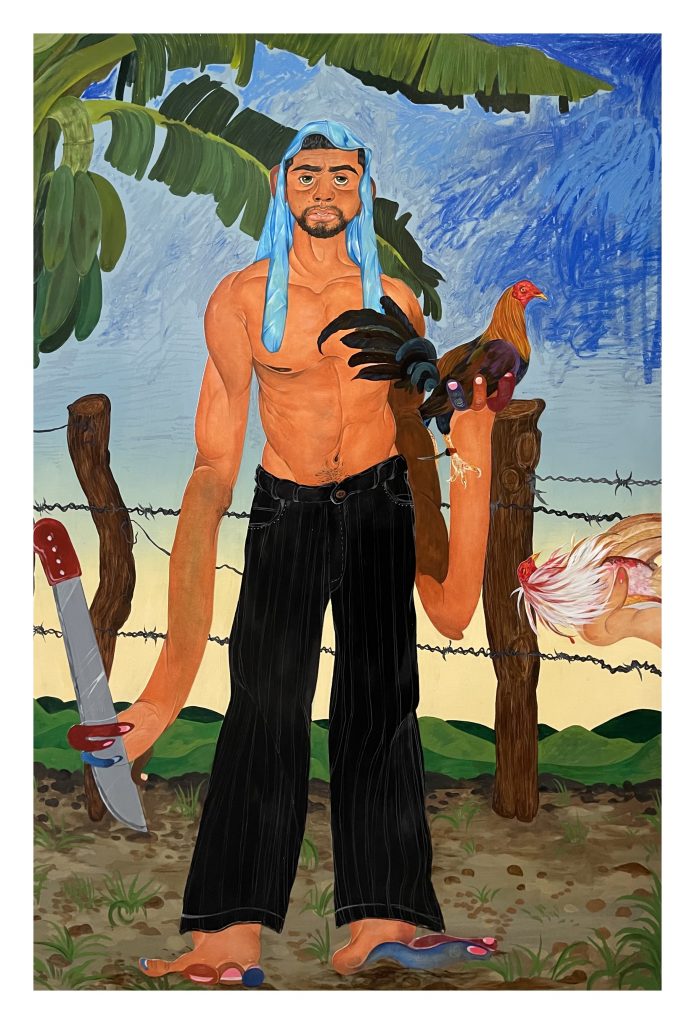
Bony Ramirez, El Gallo Ganador.
Can you share a work that particularly resonates with you?
El Gallo Ganador. This painting depicts a man in the countryside. He’s holding his winning rooster and a machete. To the side, there is a rooster that is dying. He is barefoot in the countryside. This work is specific to the life that I left in the Republic; rooster fighting is very common in my country.
I wanted to depict a part of my life growing up, and a part of Caribbean life that’s not really common to the rest of the world. The painting is set in the countryside where I grew up. The streets are not paved, there is barbed wire in the back. It’s not one of those tropical advertisement-looking paintings.
I get mad when I search for the Dominican Republic online, and all I see are beaches. It’s more than that. This particular work is important for showing the difference.
Another painting that I would say is another indication of life in the Caribbean is Adonde están los limoncillos? My work also deals with topics of colonialism in the Caribbean, as a way of informing people about what happened, how it happened, how we got our language, and how we got our traditions. Adonde están los limoncillos? is a painting of a woman laying down with a mask and torturing this man. It’s not a literal story, but it’s almost like a metaphor for the reconquering of the land.
There are other pieces about the uniqueness of growing up in the Caribbean and the different things that we do. One example is Adonde están los aguacates? It’s one of the works that was recently acquired by the Miami ICA.
It’s a little girl with her dress holding like a bunch of avocados. It’s about growing up. Going to your neighbors yard, and throwing rocks at the avocado tree, trying to steal them. It’s kid stuff! I grew up doing it, so I wanted to take it into painting.
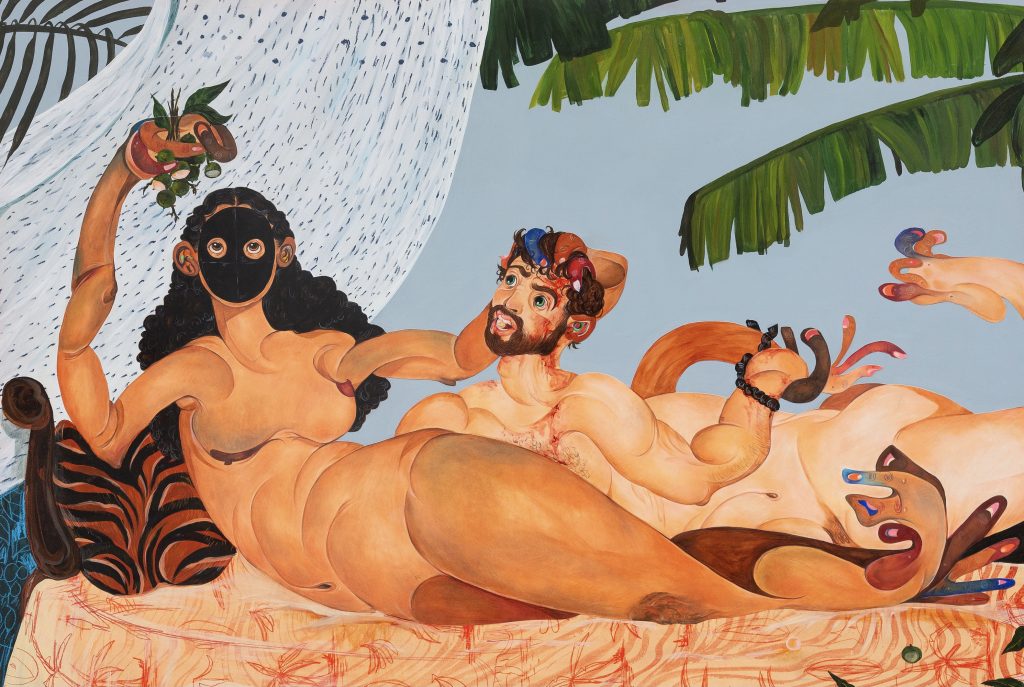
Bony Ramirez, Adonde están los limoncillos?, 2020.
Saudade is a word for a sad state of intense longing for someone, something, or someplace that is absent. Your works conjure this feeling in me. Do your works grow out of this feeling? Is it how you keep Caribbean color despite years in a gray landscape?
Definitely. Ever since I got to this country in 2009, I haven’t been back to the Dominican Republic. All of my work is from my mind. I don’t use photos as references. Depicting my childhood experiences and scenes from where I used to live is a way of not letting go of my memories. In the process of making a painting, I’ve had to force myself to remember specific plants or objects that I want to paint. I have to remember. I don’t have references in front of me, and I don’t Google because it’s not as genuine as a memory.
Race in the Caribbean, and Latin American at large, is treated very differently than in the United States. What I notice about your figures is a universality; characters of every color, shape, size, and stage of life.
Like you said, we view things differently in our countries. So my figures, in general, provide a world view of what the Caribbean is, and the diversity that there is. It was important for me, as a figurative artist, to show that diversity; to show how we are, how different we are, and how unique we are, in our own way. My figures are very diverse in size, skin color, which is what I grew up seeing. It’s what my family members look like.
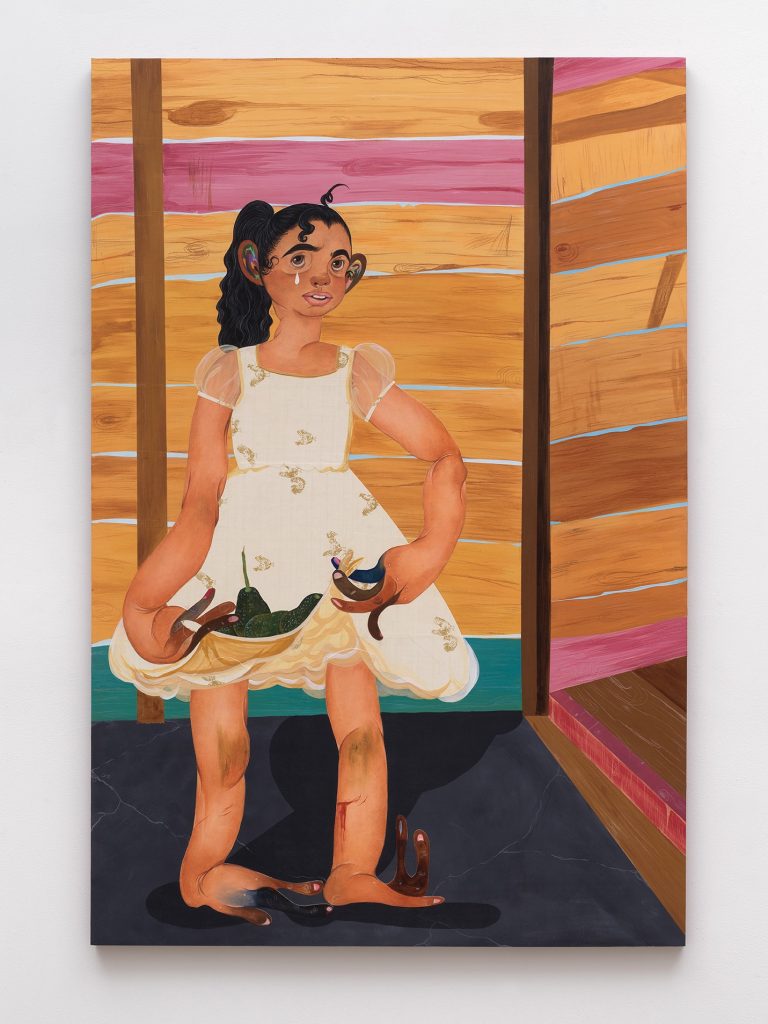
Bony Ramirez, Adonde están los aguacates?, 2021.
Along this journey, were there any artists that you looked to for inspiration in their path or their work?
My first exposure to art was the Renaissance. Back in the Dominican Republic, my mom used to take us to church every single day, except Thursday. My first exposure was all the saints they had around the church. I thought, “Oh wow, it’s a beautiful painting. It’s a beautiful sculpture. That’s what I wanna do.” When I was little, I would copy the Saints and make other little drawings and give them to people in church and the town.
Later, while doing research, I came across the work of Francis Bacon, and through him, I discovered Picasso, which took me back to the Renaissance. I discovered the Mannerist movement. I was looking for artists that really dealt with examining the human form and human body. I was never good at proportions in school. So, I really wanted to embrace that part of me and take it to the next level. These artists really push the human anatomy to show different ways of being a human, which is what I do with a little sprinkle of Caribbean life and culture.
The art world is exploring new realities and seeing great artists emerge. How do you think people from the Americas are seeing ourselves in this world? What do you see as our place in history? We are in a time to reclaim it, so what is your vision?
I love how we can see ourselves in the future. We’ve been forgotten for so long in history, whether it’s Latin American or Caribbean history, our cultures, or our traditions. We are not talked about. Now that we have become more seen, I think we will have a real place in history for future generations. That’s one of the things that I hope to achieve with my work. To give the world a different version of what the Caribbean is through my work. Another part of making it as an artist, and another layer of responsibility, is incorporating tales about living in the Caribbean as a queer kid.
That’s why museum acquisitions are very important to me. I see museums as vessels for history. When the museum doesn’t have us in it, it’s difficult for the future generation to really learn about us. I have seven museum acquisitions and I have cried each and every time. Museums were my school. It was where I went and still go to learn. Those were my influences because that’s what I was exposed to. Not artists like me, you know? You barely see our people represented and if they’re represented, it’s most likely in a demeaning manner.
When I’m dead and this museum still has my paintings, our people will say, “Okay, this is what we were.” They will see accurate representation of what the Caribbean is.
